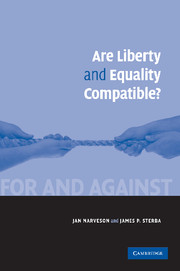2 - Equality is compatible with and required by liberty
Published online by Cambridge University Press: 03 May 2010
Summary
Is liberty compatible with equality? Following out the strategy proposed in the general introduction, I will seek to answer this question by starting with the libertarian's own ideal of negative liberty and then try to show that that ideal, when correctly interpreted, leads to substantial equality. I will then turn to an examination of other arguments that have sought to support similar conclusions and explain why those arguments are not as effective as my own. Finally, I will consider the main objections to my argument that have been raised by libertarians and my replies to those objections, where I will take up, in particular and at length, Jan Narveson's own objections to my argument from liberty to equality.
The practical requirements of liberty
From liberty to welfare
Libertarians like to think of themselves as defenders of liberty. F. A. Hayek, for example, sees his work as restating an ideal of liberty for our times. “We are concerned,” says Hayek, “with that condition of men in which coercion of some by others is reduced as much as possible in society.” Similarly, John Hospers believes that libertarianism is “a philosophy of personal liberty – the liberty of each person to live according to his own choices, provided that he does not attempt to coerce others and thus prevent them from living according to their choices.”
- Type
- Chapter
- Information
- Are Liberty and Equality Compatible? , pp. 7 - 120Publisher: Cambridge University PressPrint publication year: 2010
- 1
- Cited by

